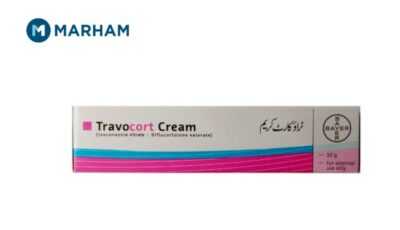Travocort cream is an FDA-approved drug that is used for the treatment of fungal skin infections. It is applied topically to the targeted site to relieve the pain and fungal infection due to the combination of corticosteroid and anti-fungal in the cream. It is prescribed during jock itch, ringworm, or other fungal infections.
Consult a dermatologist for a prescription before using Travocort cream for fungal infections.
Available Strengths of Travocort Cream
Travocort cream is available in the following strengths:
- Travocort cream: 10 grams
Manufactured by: Bayer Pharma
Generic: Diflucortolone valerate (0.2%) and Isoconazole nitrate (1%)
Drug Class: Topical Antifungal
Product form: Cream
Mechanism of Action
Travocort contains a combination of isoconazole and diflucortolone. Isoconazole is an antifungal that disrupts the fungal cell membrane and thus inhibits the growth of various fungal organisms.
Diflucortolone is a corticosteroid that works by reducing inflammation, redness, and itching. These ingredients provide a powerful solution for treating fungal skin infections and inflammation.
What are the Uses of Travocort cream?
Travocort is an FDA-approved topical antifungal that is used during the following conditions;
- Tinea Infections: Travocort 10g treats fungal infections like athlete’s foot, jock itch, and body ringworm. It relieves symptoms such as itching, redness, and inflammation.
- Candidiasis of the Skin: The antifungal cream is prescribed during yeast skin infections. It also reduces the redness and rashes due to the infection.
- Inflammatory Skin with Fungal Involvement: The combination of corticosteroid and antifungal in Travocort helps to relieve discomfort and pain due to skin infections such as eczema.
In addition to the above, Travocort 10g is also prescribed by the dermatologist during secondary infections due to its steroidal properties.
What is the Price of Travocort cream in Pakistan?
The price of Travocort cream 10g in Pakistan ranges between 175-180 PKR. The exact price can vary depending on the manufacturing company and the retailers.
Alternatives of Travocort Cream
The available alternatives to Travocort cream include:
- Hydrozole Cream 20gm
- Etrin Cream
- Difzole Cream
- Bravocort AF Cream
How to Use Travocort?
Follow these general instructions for using Travocort;
- The cream is for external use only.
- Follow the cream’s dosage and dosing frequency to avoid adverse effects.
- Before application, clean the targetted site to reduce the chances of contamination.
- Take the cream and apply it to the infectious site. Massage thoroughly until fully absorbed.
- Use the cream twice a day or as prescribed. Avoid covering the skin after application if not advised.
Dosage of Travocot Cream
You should follow the dosing regime prescribed by the doctor for your medical condition.
- The usual dose of Travocot cream is two times a day.
- Do not exceed the recommended dose to avoid possible side effects.
What are the Side Effects of Using Travocort 10g cream?
A few side effects that are reported with the use of Travort cream include;
- Allergic reactions
- Skin irritation
- Burning
- Allergies
- Redness
- Itching
- Stretch marks
Discontinue the use immediately and consult a dermatologist if any side effect persists or worsens.
Interactions of Travocort Cream with Other Medicines
So far, no drug interactions of the Travocort cream have been reported.
To avoid any drug interactions, it is better to tell your doctor the complete medical history and the medicines that you’re already taking.
Warnings and Precautions Associated with Travocort Cream
The warnings associated with the use of Travocort cream include the following;
- Avoid the use of cream for extended periods until not prescribed.
- Inform the doctor about all the medical conditions you have and the medicines you are taking to avoid drug-disease or drug-drug interactions.
- In advance, inform the doctor if you are allergic to any medicinal component to avoid complications.
- Avoid driving for at least 30 mins to 1 hour after using the medicine.
- The cream is not recommended for bacterial or viral infections such as skin TB, syphilis, shingles, or herpes.
Is it Safe to Use Travocort During Pregnancy?
Steroids, like those found in Travocort, are generally not recommended during pregnancy. Avoiding Travocort during the first trimester is recommended to prevent potential developmental issues in the baby.
If you’re breastfeeding, be cautious with Travocort. It’s recommended to avoid over-the-counter usage, and it’s essential not to apply it directly to the breasts. This precaution ensures that the baby doesn’t ingest any medicine. Always inform your doctor if you’re pregnant, planning to conceive, or breastfeeding before considering using Travocort.
What are the Effects of a Travocort Cream Overdose?
In case of an overdose or swallowing, it is advised to talk to your doctor immediately. It is unlikely to cause any dangerous effects but contact a pharmacist or doctor.
Missed dose
It is recommended to take the tablet according to the prescribed dosing schedule. However, if you miss a dose take it as soon as you remember. If the time of the next dose is near, skip the missed dose and take the upcoming dose as per the schedule. Avoid doubling the dose as it may result in overdose symptoms.
How to Store Travocort?
- Keep the medicine out of the reach of children.
- Keep the cream in a cool and dry place.
- Store it away from direct sunlight and moisture.
FAQs
1. Is Travocort safe for babies?
Avoid using any medicine on children without a prescription. Travocort is not recommended during pregnancy and lactation due to the possible risks in babies.
2. How quickly does fungal cream work?
Topical creams like antifungals take 6-7 days before showing their effects. Avoid discontinuing the use after 1-2 days if the effects don’t appear.
Disclaimer: The content published on Marham.pk is for informational or educational purposes only, produced from FDA-approved literature, and does not substitute professional medical advice. Please consult your healthcare provider before using a prescription or over-the-counter drug, or any other treatment option.

